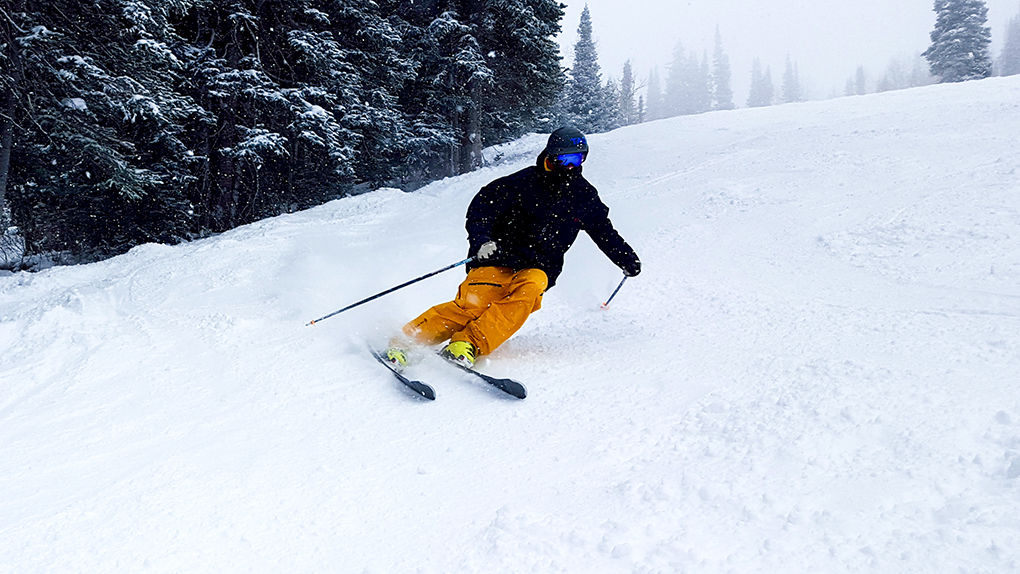Flex and Performance with Comparisons
The AllTrack Pro 130 WTR is listed as a 130-flex boot. I’ve been in both the 14/15 and 15/16 models of this boot, and have found the 15/16 to actually feel a little stiffer than the “pre-production” version of the 14/15 I used, especially when it’s super cold.

During “normal” winter conditions, I found the AllTrack softer than the BD Factor MX, Tecnica Cochise Pro, and 28.5 Dalbello KR2 Pro, but stiffer than the 27.5 KR2 Pro, and Il Moro T Comp.
The boot does provide a nice progressive feel to the flex, which is in contrast to the springy-wall-like block I personally experience when pushing up against the Factor MX. Overall, there have been times (driving big skis through very challenging conditions) when I’ve wished for a bit more power from the boot with the same degree of progression, but under most circumstances, the boot delivers the support I have needed.
Of note, I have found the 15/16 version of this boot to be greatly impacted by fluctuations in temperature. While very cold temperatures help stiffen up the boot slightly, when temperatures go above freezing, this boot becomes downright soft, and has often left me wishing for more.
Laterally, the boot delivers strong pressure to the edges well and does so without feeling overly twitchy. I noticed a slight increase in edging power with the Cochise (and even more so with the Factor MX) with the best balance of power and forgiveness being the Cochise.
Weight
To be very straightforward, weight is the biggest downside I have found with the AllTrack Pro. Whether out ski touring, swinging my feet back and forth through moguls, or while spinning/flipping through the air, the additional weight of the boot is definitely noticeable., especially compared to the competition:
- AllTrack: 5148 g per pair
- Cochise: 4581 g per pair= -1.25 lb difference
- Factor MX: 4357 g per pair = -1.74 lb difference
The Cochise shaves weight via its shell, while the Factor is significantly lighter in both the shell and liner. Since the Factor’s liner is 100% heat moldable, I ended up using it in all three boots with great success. This liner swap dropped over a pound off the AllTrack, which was noticeable and beneficial. If weight is a concern to you, I would highly suggest looking into a pair of Intuitions or similar lightweight liner options.
Walk Mode
The walk mode has worked perfectly and has not developed any play during my time with the boot. Transition between the two modes is simple, as a flip of the small lever and a firm press into the tongue does all that is needed to position the lock block into the desired position. I did find it beneficial to make the switch to/from walk mode with the upper cuff buckle tight, as loosening the buckle prior to the switch can make it difficult to pressure the tongue enough to unlock/lock the lock block.

Switching into walk mode allows for a noticeable increase in rearward cuff motion, but does not increase forward motion a perceptible amount. I found the range acceptable, but cuff movement is less than the Cochise and significantly less than the Factor MX.
Buckles / Soles
The buckles of the AllTrack are low profile and have a little flair on the trailing edge that permits an effortless single finger release. The cuff buckles have a handy extension hook that allows them to be left very loose while skinning or hiking, yet still keep the cuff from splaying open. Overall, the buckles leave little to be desired.

New for 15/16 on the AllTrack Pro 130 are the Walk-to-Ride (WTR) soles. Unfortunately I haven’t had a ski setup to accommodate the WTR sole, so all I can comment on is the ease of swapping out the WTR sole to the traditional DIN sole. The process requires only a Phillips head screwdriver and about 15 minutes.
Warmth
Rossignol touts the use of Thinsulate Platinum insulation in the liner for added warmth. In general I run pretty warm, but quite commonly still experience cold toes. Compared to the plethora of other boots I have been in I would call the AllTrack as a bit above average in keeping my toes warm, but on super cold days I still usually end up taking a break for a warm-up, just like with any other boot I’ve been in.
Durability
While I did end up having an issue with the pre-production boot I had, I have been in the 15/16 AllTrack since the middle of last season, and have not experienced a single issue with durability. As stated earlier, the walk mode is as tight as day 1. The buckles, liner, and soles are all holding up well. At this point, I don’t see why these wouldn’t last most skiers a great number of seasons without any problems.
Bottom Line
Due to the well-shaped shell and liner, I believe that many feet will find comfort in the AllTrack Pro 130 with minimal alterations. Also, in true Rossignol fashion, while the boot may not be the stiffest boot out there, it does offer strong and predictable control that I have come to appreciate, and that will likely make far more skiers happy than if the AllTrack Pro 130 was the stiffest boot out there.
If you are a large and powerful skier always looking for the stiffest boots you can find, I’d suggest looking elsewhere. But if you like to ski all over the mountain and want a boot that will instill confidence, and don’t mind the weight, the AllTrack Pro 130 WTR definitely deserves consideration.
